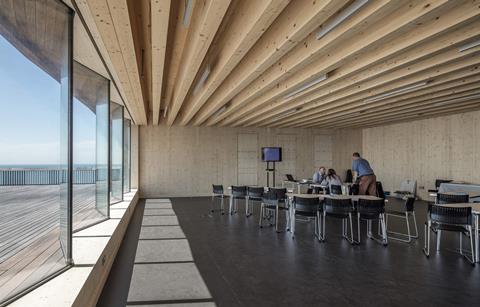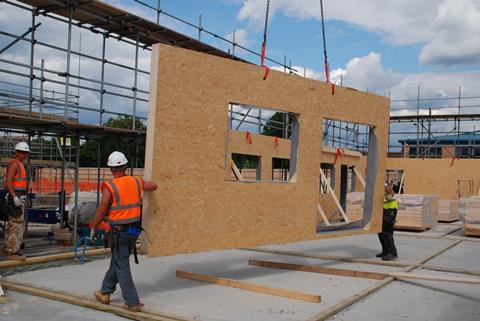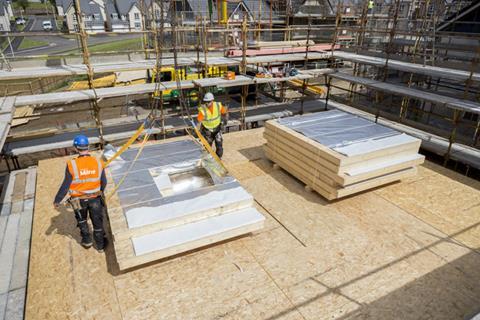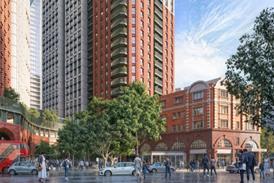As the UK construction industry races to meet Net Zero targets by 2050, structural timber is emerging as a vital solution to reducing embodied carbon and transforming building practices. But this shift demands more than a material swap – it calls for a redesign of how we build. With the right training, early collaboration and targeted guidance, architects and specifiers can lead the way in mainstreaming timber and creating a more sustainable built environment

The construction industry stands at a critical juncture. If the UK is to meet its commitment to achieve Net Zero by 2050 and reduce embodied carbon in construction, the industry must improve the sustainability credentials of the buildings it constructs. This is likely to involve a move to a more sustainable building material, such as timber, that offers a sustainable, efficient and high-performance alternative to other products.
With buildings responsible for 40% of the UK’s carbon emissions and construction activity alone generating 50 million tonnes of CO2 annually, the path to Net Zero by 2050 demands more than incremental change – and crucially, it requires a fundamental shift in how we approach construction.
Early timber integration enables architects to harness the material’s unique properties while optimising structural performance, construction speed and long-term sustainability.
Undoubtedly, structural timber has a vital role to play in reshaping the future of construction in the UK, with benefits that extend far beyond sustainability. From speed and efficiency to compliance and cost-effectiveness, timber presents a compelling case for widespread adoption.

What does this mean for architects and specifiers?
To successfully transition to timber as a construction material, we cannot simply replace other materials in a like-for-like fashion. Instead, we must design with timber in mind – not only to make the best use of the material, but to ensure that it is used in the most efficient way. As such, early collaboration at the design stage between the client and architects, along with any other key stakeholders is crucial to achieve sustainable buildings with high performance and energy efficiency.
This switch to timber requires architects to build confidence in their competency, skillset and informed design approaches. Architects play a pivotal role in this shift, and as demand for sustainable solutions grows, so does the need for expertise in structural timber.
We therefore must build an ecosystem of knowledge, skills and support – the importance of which was highlighted in the UK Government’s Timber in Construction (TiC) Policy Roadmap. To achieve widespread adoption of timber, architects and designers must go beyond simply substituting materials and instead integrate timber-specific design principles.

Construction skills urgency
A well-trained workforce is crucial for high-quality timber construction, and the TiC Policy Roadmap emphasises the industry’s need to upskill professionals, attract new talent and ensure adequate training for existing workers. However, the sector faces several challenges, including a lack of formal education on timber construction in architectural programmes, a need for expanded Continuing Professional Development (CPD) initiatives focusing on timber engineering and whole-life carbon considerations, and a shortage of skilled tradespeople trained in proper timber system installation. To address these gaps, industry bodies like the STA play a vital role in providing resources, training, and an assurance scheme.
Supporting and educating
To support best practice in the growing use of timber within buildings, the STA has released a short ‘Structural Timber: Design and Construction Guidance’ – a guide for architects, engineers, developers, and insurers, that is aligned with the RIBA Plan of Work.
The STA’s new guidance looks at project inception through to completion and long-term use, providing essential resources for those less familiar with structural timber systems, ensuring timber is integrated into construction projects efficiently, safely and sustainably.

Covering the eight stages of the RIBA Plan of Work, the guide outlines key considerations, including early-stage planning, technical design, procurement, fire safety, moisture management, and construction logistics. It also provides valuable insights into structural timber construction methods, such as open and closed panel timber frames, structural insulated panels (SIPs), cross-laminated timber (CLT), and volumetric modular systems.
The STA remains committed to ensuring the highest standards in timber construction through initiatives such as the STA Assure quality assurance programme and the Installer Training Scheme (ITS). The document also addresses critical industry challenges, including market confidence among lenders and insurers, and provides recommendations to mitigate risks associated with fire safety and moisture ingress.
Unquestionably, the transformation of the UK construction industry towards Net Zero emissions requires a fundamental shift from traditional material selection to timber-integrated design thinking. With buildings contributing 40% of UK carbon emissions, incremental changes will not suffice – the industry must embrace structural timber as a design driver from project inception, supported by the comprehensive education, skills development and collaborative frameworks provided by thorough guidance and training initiatives.
The window of opportunity is narrowing, but the infrastructure for change is in place. With the TiC Policy Roadmap charting the course and industry bodies providing essential tools and training, the coming years represent a pivotal moment for sustainable construction. The question is no longer whether timber can meet our Net Zero aspirations, but whether architects and designers will seize this opportunity to lead the transformation towards a truly sustainable built environment.
Click here for more information on ‘Structural Timber: Design and Construction Guidance’.
Postscript
Paul Newman is technical director at Structural Timber Association (STA)















